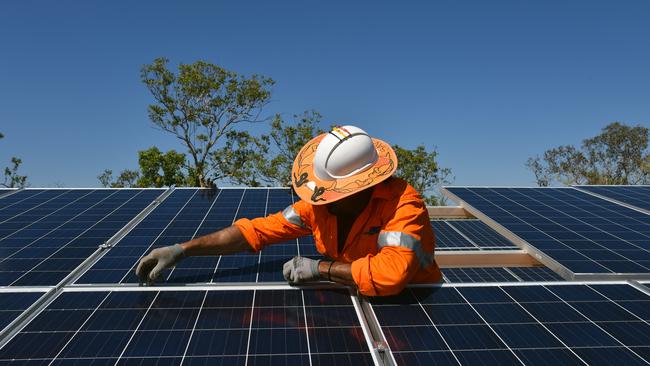Angus Taylor backs gas as renewable power surges
Renewable energy generation increased by 15 per cent last in the 2020 financial year but more than three-quarters of Australia’s electricity came from fossil fuels.

Renewable energy generation increased by 15 per cent last in the 2020 financial year but more than three-quarters of Australia’s electricity came from fossil fuels.
A report by the Department of Industry Science Energy and Resources released on Tuesday showed Australia’s energy consumption fell by 2.9 per cent in 2019-20 because of the Covid-19 pandemic.
Coal was the source for 55 per cent of electricity generation, while gas generation rose 5 per cent to account for 21 per cent of Australia’s power.
Renewables provided 23 per cent of electricity in 2019-20 — growing to 24 per cent by the end of the calendar year — with a 42 per cent increase in solar generation and 15 per cent increase in wind generation.
“Australia last saw a renewables share of total generation this high in the mid-1960s when the Snowy Mountains hydroelectric scheme came progressively online,” the Australian Energy Update report said.
Gas accounts for 27 per cent of Australia’s energy when industrial processes are included, while LNG production increased by 8 per cent on the back of international demand.
Energy Minister Angus Taylor said the statistics showed there was growing need for gas in the electricity sector, as the government pulled-the-trigger on a budget promise to provide $30m for a gas plant in Port Kembla proposed by billionaire Andrew Forrest.
The funding can be overturned in the Senate if Labor, the Greens and the crossbench pass a disallowance motion.
Squadron Energy, a subsidiary of Mr Forrest’s Tattarang group, is proposing a “development pathway” for the gas plant to be converted to a green hydrogen generator by 2030.
With a spike in international gas prices undermining the government’s push for a “gas-fired recovery” from Covid-19, Mr Taylor said new supply was needed to make energy more affordable.
The push for new supply to drive down gas prices would be opposed by green groups and environmentalists, given the International Energy Agency this year declared there was no need for new gas fields to be opened up as the world pursues net-zero emissions by 2050.
“New gas supply and generation will help re-establish a strong economy and make energy more affordable for families and businesses, while complementing the world- leading levels of renewables in Australia,” Mr Taylor said.
“Gas supports jobs in our important energy intensive industries that are the lifeblood of our economy and our regions.”
Mr Taylor said gas was essential to balance the growth of intermittent renewables.
“The energy system is changing at an unprecedented pace, which is why we need to get the energy balance right to ensure Australian households and businesses can continue to access the power they need to grow and prosper,” he said.
On Monday, the IEA named Australia as one of the key countries best placed to produce hydrogen from renewables, known as “green hydrogen”.
But IEA executive director Fatih Birol warned a global investment of $US1.2 trillion in the fuel was needed by 2030 to prepare the world for a carbon neutral future.
“Australia’s potential to produce hydrogen from renewables is considerable. Currently, nine projects with a capacity greater than 1 gigawatt are under development or at early stages. These include some of the world’s largest projects,” Mr Birol said.
“If all projects under development are deployed, electrolysis capacity in Australia will reach nearly 20GW by 2030 (33GW including early-stage ones), the vast majority aiming to export hydrogen and ammonia.”
Mr Birol said governments need to move faster and more decisively on policy measures to enable low-carbon hydrogen to fulfil its potential to help the world reach net zero emissions.
“We have experienced false starts before with hydrogen, so we can’t take success for granted. But this time, we are seeing exciting progress in making hydrogen cleaner, more affordable and more available for use across different sectors of the economy,” he said.
The Morrison government first developed a national strategy to turbocharge the industry two years ago and plans to develop a new export industry responsible for 8000 jobs and $11bn of extra income by 2050.
Australia’s biggest hydrogen developers in September called on the Morrison government to create a $19bn Net Zero fund, aimed at slashing emissions and speeding up the fuel’s rollout to the steel and heavy transport industries and in the nation’s gas sector by 2030.
With business leaders calling on Scott Morrison to commit to net-zero emissions by 2050 and adopt more ambitious 2030 targets, the industry wants the big commitment from Canberra to ensure business can become a global hydrogen player by the end of this decade and a top-three exporter of the fuel to Asian markets.


To join the conversation, please log in. Don't have an account? Register
Join the conversation, you are commenting as Logout